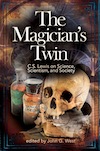 Culture & Ethics
Culture & Ethics
 Evolution
Evolution
 Faith & Science
Faith & Science
Dragon’s Blood: A Fascinating Detail in the Cover Design of Magician’s Twin
 Those readers who have already obtained a copy of the marvelous and insightful Magician’s Twin: C. S. Lewis on Science, Scientism, and Society will notice the fascinating cover design which includes a bottle labeled Sanguinis Draconis (“dragon’s blood”). This refers to an ancient remedy (Calamus rotang) allegedly first obtained from the small archipelago Socotra in the Indian Ocean by the Arabs where they introduced it to the Chinese.
Those readers who have already obtained a copy of the marvelous and insightful Magician’s Twin: C. S. Lewis on Science, Scientism, and Society will notice the fascinating cover design which includes a bottle labeled Sanguinis Draconis (“dragon’s blood”). This refers to an ancient remedy (Calamus rotang) allegedly first obtained from the small archipelago Socotra in the Indian Ocean by the Arabs where they introduced it to the Chinese.
It is there, some say, that merchants applied the name “dragon” to the plant to please their customers, and the idea of “blood” is easily suggested by the bright red resinous juice obtained from the plant. As time passed it found its way into the materia medicas and lore of Europe, including England where A. C. Wooton says, “In some parts of the country it has a reputation as a charm to restore love.”
Having spent some years writing about the 17th-, 18th- and 19th-century materia medicas (e.g. The English Physician), I immediately thought, How appropriate! Lewis believed that magic and science “are twins pour et cause,” and so the images of ancient and mysterious remedies pointing to the alchemical art seem appropriate, but how much more so dragon’s blood! This “love restorer” was much sought after by maidens who, spurned by their former interests, would take some of the product and throw it into a fire, reciting: “May he no pleasure or profit see / Till he come back again to me.”
Looking at the Magician’s Twin cover I thought, This looks like the table of the scientistic magician attempting in vain to cast his spell upon Lewis to woo him back to his former atheism. I doubt this was intended, but it was nonetheless a masterstroke.
Professor Flannery is the author of Alfred Russel Wallace: A Rediscovered Life (Discovery Institute Press) and other books.
